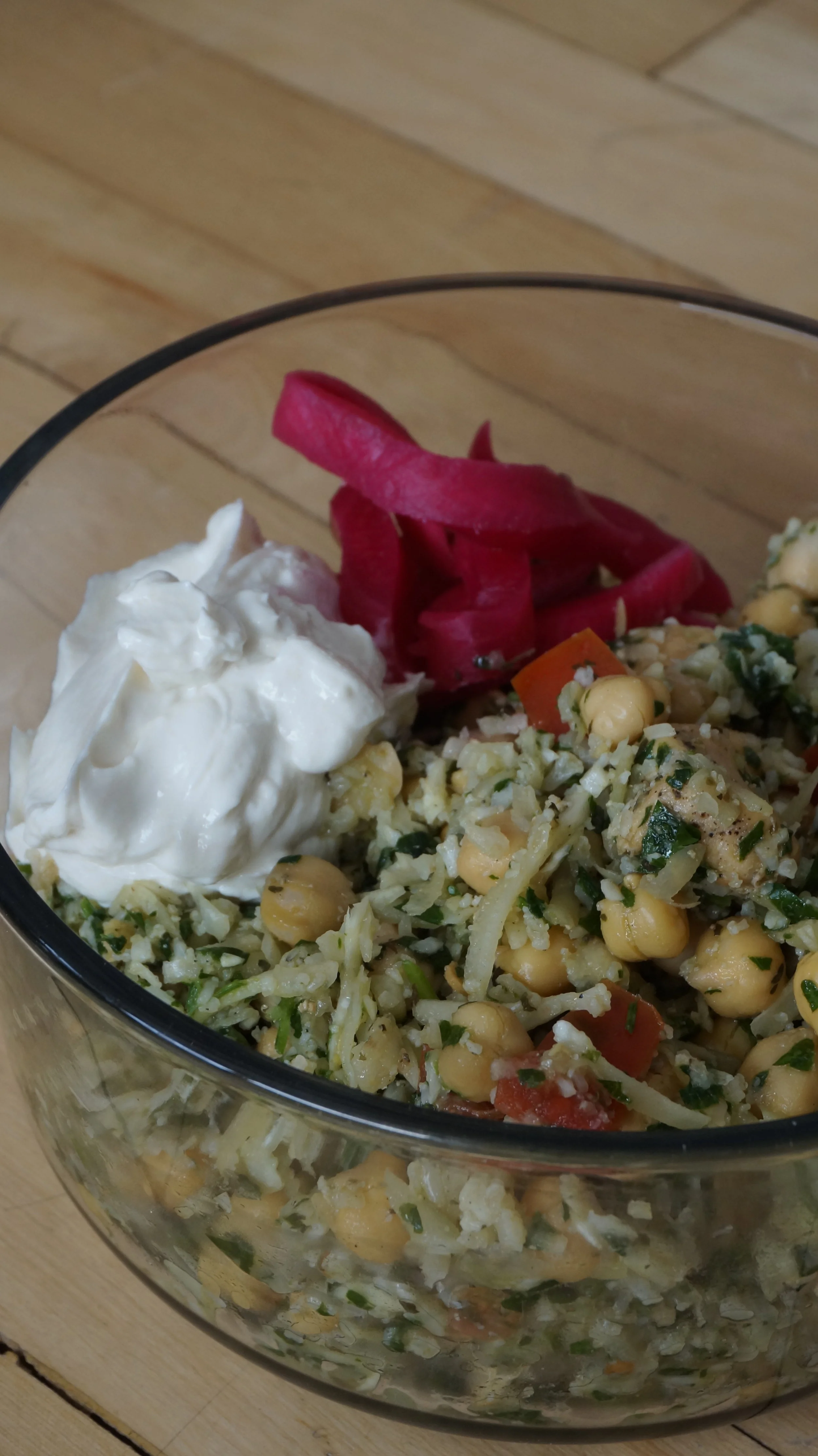Kombucha (or, as I like to call it.. booch), seems to be the new saving grace for getting probiotics into the body and back into the health and wellness conversation. But is it enough? How did these fermented foods that supply us with healthy critters leave our everyday diet and are we getting enough these days? I’m going to go over a brief history of fermented foods, why they’re food for you and why we need to consider prebiotics as well.
Kimchi is another popular fermented food full of probiotics as long as it isn’t steriiized. Find this Turmeric Chicken and Napa Slaw with Kimchi on my new Spring Menu! Find it here.
Back in the day we used to ferment all sorts of foods depending on what was abundant and what was in season. Pre-refrigeration and pre-ample-amounts-of-electrical-energy, we just let cabbage bubble away in a salt brine to make sauerkraut. The food gets a health boost as human-safe microbes in the air and/or on the vegetable, grain, dairy product transforms the food or drink into a probiotic hotel. Bad bacteria and mould don’t grow on this if the environment (temperature, humidity and salt content) is on point. It’s a lot less scary after you’ve done it a couple of times and there are some amazing books on the topic. Just reference the king of fermentation, Sandor Katz, for all your fermentation questions.
Sandor and I at Ballymaloe LitFest in 2014. Read more about my LitFest writing experience here.
We get all sorts of benefits by consuming these foods. Scientists are finding out more and more ways that a diverse microbiome (the population number and diversity of microbes in your intestinal track) affects a lot of preventable mental and physical problems.
Industrialization of food makes it simpler to make pickles without getting the critters and a bunch of time involved. Heating up vinegar and salt preserves vegetables and makes them have a similar flavour as they had back in the day when they were slowly fermented over time. Not only that, but these pickles are shelf stable which require no refrigeration and thus not as beneficial to your health because any beneficial bacteria that may have been on it has been destroyed in sterilization. Have you ever noticed that kosher pickles are usually in the refrigerator compared to other pickles in the grocery store? The cloudiness at the bottom of the kosher pickles indicates there are some happy probiotics in there.
Did you know that some store bought brands of yoghurt, cheese and sour cream aren’t slow fermented the traditional way? Why don’t you try to make your own? Next weekend project!
So, here we are. We know that we don’t preserve food at home because we can buy all these tangy delights but we also have access to year-round vegetables and don’t feel the pressure to need to save them.
But what about prebiotics? This is starting to get in the mainstream health vernacular and for good reason. Microbiology 101 for ya’ll.. microbes need food. So, what you eat beyond probiotic containing foods and drink (yoghurt, booch, fermented pickles, etc.) is just as important to ensure that the population of these thrive and are not taken over by other ones that can harm you. That’s where the other buzz worthy health topic comes in: sugar.
A word on carb consumption. Before you close this window and go on a tirade, I’ll explain what happens. The microbe world is incredibly diverse and if you eat too many quick-to-digest (refined sugars like in sodas, fruit, white breads, etc) you feed a population of gut bugs that can harm you. The problem #1 is how much is ‘too much’ sugar is really person dependent and it also depends on what else you eat. The second problem is that, like me, you can remove most carbohydrates from your diet and heal your microbe population over time but just to write off all carbs isn’t the answer. See, I told you I wasn’t evangelical about carbs!
It’s cool to think that cooled cooked potatoes and rice can actually digest in your body differently than freshly cooked. There’s so much to learn about nutrition.
Ok, so prebiotics are also known as non-digestible fibers that, well, don’t get digested in your intestinal tract but probiotics feed on them. And yes, fiber is technically a carbohydrate. Semantically speaking then I think it’s unwise to completely write them off. Depending, though, on your carbohydrate tolerance, you can even incorporate potatoes in your diet if they’re cooked and cooled. Resistant starches are one of these non-dgestible prebiotic resistant to breaking down which means that it theoretically shouldn’t boost your blood sugar. You can figure out how to prepare common foods like potatoes, rice, etc to increase their resistant starches and lower their glycemic index in this article.
This is how I developed my Spring menu for my clients. I made sure there were lots of spring greens and radishes to remind us of the coming local veg and threw in lots of pre and probiotics. We have some kimchi, fermented kosher pickles and yoghurt for probiotics and come cool potatoes, sweet potatoes, onions and garlic for prebiotics. Find out more about it on my services page!
Cauliflower Tabbouleh on my Spring Menu! Comes with a delicious tahini greek yoghurt. Find out more here.






